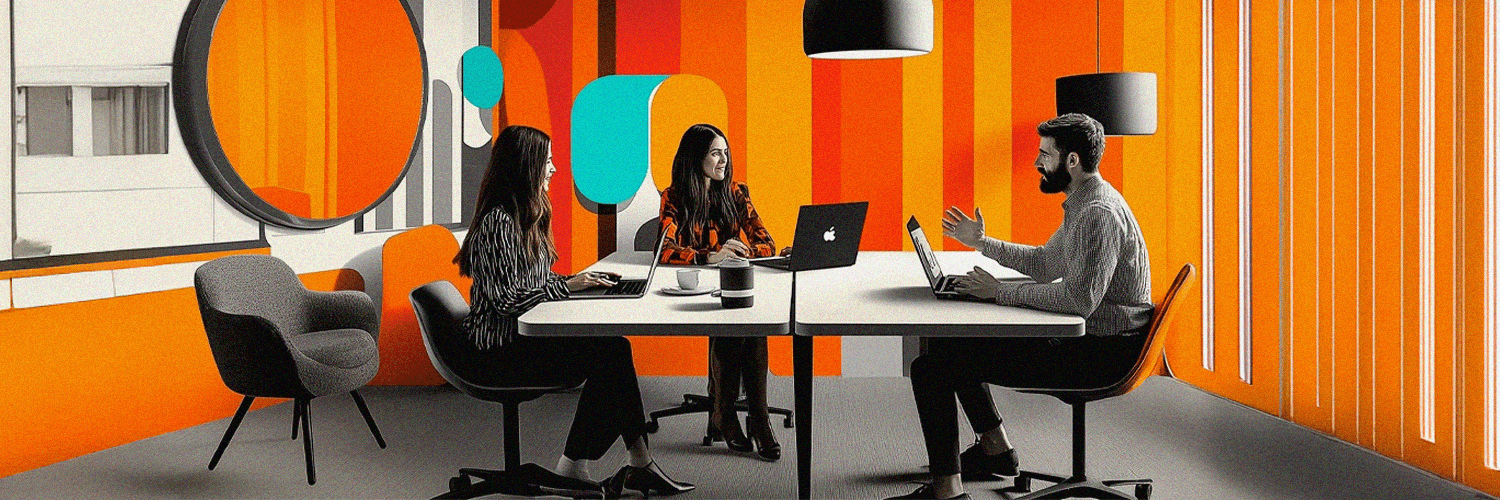Want to set up an office that's designed to meet the needs of your hybrid workforce? With the rise of flexible work schedules, it's more important than ever to create a workspace that is both efficient and adaptable.
The key lies in tapping into employee behavior data. By understanding how your employees use their workspace, you can create a workplace that enhances collaboration, productivity, and overall well-being.
We'll explore what a hybrid office entails, the challenges of designing one, how to measure success metrics for such offices, and the benefits they offer. Finally, we’ll take a look at what the future holds for the modern hybrid workplace.
TL;DR:
- A hybrid office is a workspace that combines elements of both traditional and remote work environments. While this brings many benefits, it also presents a number of challenges – including office design.
- Measuring the success of a hybrid office depends on the goals of each company, so it's important to define clear benchmarks to determine success before implementing any workplace design changes.
- To make sustainable workplace changes that effectively support hybrid employees, leaders must develop a comprehensive understanding of how their facilities are used – by paying close attention to data.
- As the hybrid office becomes more popular, it's important to think about how this will affect office design in the long term. Collaboration, technology, and health and wellness are all important aspects to consider.

Defining a Hybrid Office
A hybrid office is a workspace that combines elements of both traditional and remote work environments. It's a flexible space designed to accommodate employees who split their time between working in-office and from home.
In this type of office model, employees have the freedom to choose where they work based on their individual needs or preferences. They may come into the physical office for meetings or collaborative work sessions while completing focused tasks remotely from home.
This approach allows businesses to optimize their real estate footprint while giving employees more flexibility over how they manage their workload, which often results in higher productivity levels and better job satisfaction.
Hybrid workplaces also foster innovation through collaboration between teams who may not have had the opportunity to interact otherwise, as well as reducing costs associated with maintaining large physical offices. Perhaps the biggest benefit of all is that it increases access to global talent pools by removing geographic barriers.
Hybrid offices typically feature open floor plans, private workstations, collaboration spaces, and video conferencing tools that enable seamless communication among team members.
The Hybrid Office and Office Design
Hybrid office design is a workplace strategy that combines elements of traditional office spaces and remote work setups, and brings a specific set of requirements for the office that vary in complexity depending on the original design of the space.
The goal, of course, is to create an environment that fosters collaboration, productivity, and employee well-being while accommodating the changing needs of modern businesses.
One key feature of hybrid offices is flexibility in physical layout. For example, adjustable-height desks can accommodate both sitting and standing positions for better ergonomics, while movable partitions or open floor plans can adjust spatial configurations as needed for different activities or team sizes.
Another important aspect is technology integration – it’s not efficient to have hybrid employees work in traditionally fully on-site workspaces. They need to be able to communicate with their remote co-workers from the office without disturbing their colleagues, so will appreciate dedicated huddle rooms equipped with video conferencing technology.
Technology isn’t required only to support virtual communication, but also to enhance task performance through smart lighting, soundscapes, temperature control systems, etc. Many hybrid offices also prioritize sustainability principles such as energy efficiency and waste reduction by using eco-friendly materials or implementing green policies like paperless workflows or bike-to-work programs.
In addition, hybrid working requires the use of smart technology tools in the office, such as room and desk booking software or in-office apps that help employees seamlessly navigate the office, regardless of how often they work on site.
What Are the Benefits of Embracing a Hybrid Office?
The hybrid office model has gained a lot of traction in recent years, as it reflects a new era of work culture where individuals seek greater autonomy and balance in their professional lives without sacrificing social interaction or organizational identity.
A hybrid office allows employees to come into the physical workspace based on their preference and job requirements, a setup that enables companies to attract top talent from anywhere in the world and retain existing staff who may have commitments that require them to work from home.
- First and foremost, the flexibility offered by a hybrid workplace model allows employees to work in the way that best suits their needs, whether that's from home or in the traditional office setting.
- In addition, this type of arrangement can also promote better work-life balance, as employees have more control over when and where they work. This can lead to increased job satisfaction and productivity levels.
- Another benefit is cost savings. Because fewer employees need to be in the office at all times, hybrid offices can reduce the overhead costs associated with renting and maintaining large office spaces.
- Meanwhile, workers can save on commuting costs and other related expenses, which can also help your company reduce its environmental impact and promote sustainable transportation.
- Although team members may not always be physically located in the same place, by leveraging tech tools such as video conferencing software and cloud-based project management tools, they can stay connected no matter where they’re working from.
With these advantages in mind, more businesses are adopting this new way of working as they recognize its potential benefits for both employee satisfaction and organizational productivity. But what about the challenges?
-3.png?width=928&height=523&name=3%20(1)-3.png)
What Are the Challenges to Designing an Efficient Hybrid Office?
The hybrid office concept is growing in popularity as companies seek to create flexible and adaptable workspaces that can meet the changing needs of employees.
Still, designing an efficient hybrid office can be a challenge for business leaders, who need to consider aspects such as ensuring equal access to technology across all locations and fostering a sense of community among geographically distant employees.
- One of the biggest challenges is identifying and understanding the individual needs of each employee, as they have different work styles, preferences and roles. Some employees need more privacy, while others are comfortable in open spaces with plenty of opportunities to collaborate.
- Another challenge is creating a flexible workplace that accommodates both remote and in-person work arrangements. This means designing a workspace that provides seamless technology integration to ensure effective communication between virtual and physical teams.
- Additionally, it's important to consider how to optimize space utilization by designing versatile areas that can quickly adapt to changing business needs. Balancing occupancy capacity limits with employee comfort levels are also essential considerations when redesigning your office space.
- Regular assessments and feedback mechanisms from employees on their experiences with the hybrid workspace model are needed, so that you can make data-driven decisions and not rely on assumptions about your workforce's behavior patterns regarding their use of shared spaces or quiet zones.
Addressing these issues requires careful planning, flexibility, creativity, and transparency in communicating changes made during the design phase. Ultimately, however, it all helps to create a workplace culture that fosters employee engagement and productivity – regardless of location.
Measuring the Success of a Hybrid Office Design
Measuring the success of a hybrid office design provides valuable insights into what works well for employees while optimizing space efficiency, and is essential to ensure that it meets its intended purpose.
- One way to do this is by using metrics such as employee satisfaction, productivity, and engagement levels. These metrics can be obtained through surveys and feedback mechanisms from employees.
- Another metric for measuring success in a hybrid office is the utilization rate of spaces. This involves tracking how often different areas are being used and identifying any underutilized or overused spaces that may require adjustments.
- The cost-effectiveness of a hybrid office design can also be measured by comparing expenses before and after implementation, including savings on real estate costs, utilities, maintenance, and equipment.
Keep in mind that the measurement of success for a hybrid office will vary depending on each company's goals and objectives. Therefore, it's crucial to define clear benchmarks before implementing any changes in workspace design.
Leveraging Data
Transforming the office into a hybrid workplace requires data. Only by analyzing data on employee demographic characteristics, departmental functions, and workplace usage patterns can organizations gain insights into their specific needs, now and in the future.
To make sustainable workplace changes that effectively support hybrid employees, leaders must develop a comprehensive understanding of how their facilities are used and design hybrid offices that provide flexibility while fostering collaboration, productivity and employee well-being.
Below are some points to look for when using workplace data to redesign the office to better support hybrid working:
Office Usage
There are many ways to gain insight into actual office space usage: two of which are office space surveys and a workplace analytics platform such as YAROOMS.
- Office space usage surveys allow business leaders to directly ask their employees about their expectations, desires, and preferences regarding the workplace to ensure that the changes being made are desirable to the workforce.
- Workplace analytics reports show how office space is being used at a given time on a given day. Using real-time data, strategists can evaluate workplace reports such as intelligent building management reports, occupancy reports, office usage reports, meeting reports, and other custom analytics.
By analyzing office usage based on analytics and surveys, you can more efficiently and accurately allocate space needs to ensure your office is right-sized to support all employees.
Office Occupancy Data
Office occupancy data helps identify trends in employee behavior. Start by monitoring occupancy data over a period of time. Analyze occupancy, capacity, popular dates and times, and times when spaces aren't in use.
For example, if occupancy data shows that hybrid meeting rooms are consistently 90% occupied, while the individual workstations remain unused most of the week, consider converting those individual workstations into rooms that support hybrid collaboration.
Or, if employees spend more time working independently than collaborating with others in the open-plan office, consider introducing flexible seating arrangements or hot-desking solutions that allow employees to choose their own workspace within the office space.
Trends and Patterns
Many workers who previously worked at your headquarters in the city may have taken the pandemic as an opportunity to move to the suburbs. Pay attention to what the data tell you.
If a particular geographic area is seeing increased hiring nearby, it could be a sign that it's time to look at downsizing, setting up satellite offices or partnering with a coworking space.
However you handle the findings, leveraging data is an indispensable tool for designing effective hybrid offices that are specifically tailored to your company's unique needs and requirements for optimal performance.
.png?width=928&height=523&name=1%20(2).png)
What Will the Hybrid Office of the Future Focus on?
As companies continue to adopt flexible work arrangements and the concept of the hybrid office gains popularity among companies worldwide, it's important to consider how this will affect the physical workplace in the long term.
Collaboration
One trend likely to continue is a shift towards more open and collaborative spaces. The traditional cubicle layout may become a thing of the past as companies prioritize creating environments that encourage teamwork and communication.
This is because today’s workers are finding themselves missing the social interaction and collaborative spaces that they once took for granted in their physical offices. With a lack of face-to-face communication, employees can sometimes feel isolated and disconnected from their colleagues.
As a result, there will be an increasing need for more collaborative spaces within the office to facilitate teamwork and socialization. These spaces will offer a chance for coworkers to come together, share ideas, brainstorm new projects or simply catch up over coffee.
By providing these areas within the workplace, companies can help bridge the gap between remote work and traditional office culture while also encouraging employee engagement and productivity levels to soar.
Technology
As the trend of remote work continues to gain momentum, offices must adapt by providing their employees with the latest tools and technology. They need to have access to top-notch hardware and software that can facilitate collaboration between team members who may be working from different locations.
This includes high-speed internet connections, video conferencing platforms, project management software, and cloud-based file sharing systems that enable seamless workflow among distributed teams.
Equipping offices with these technologies is essential for businesses looking to remain competitive in today's fast-paced digital landscape and not get left behind as workers embrace hybrid work opportunities.
Health & Wellness
Across the globe, health and wellness have become priorities for individuals, especially in the wake of the COVID-19 pandemic. The two play an important role in shaping tomorrow's hybrid office by influencing workplace design elements, such as:
- air quality
- ergonomic furniture
- greenery
- natural light sources
- flexible workstations
As we move toward a hybrid office model that combines remote work with physical office space, it is imperative to prioritize these aspects and incorporate features that support them.
Companies should also invest more in mental health resources, such as counseling services or meditation rooms, to help employees effectively manage their stress levels.
By prioritizing workplace health and wellness, employers can increase productivity, improve employee satisfaction, and reduce absenteeism due to illness or burnout.
Overall, promoting healthy habits within a hybrid workspace is not only crucial for individual well-being but also contributes positively to organizational success.
Conclusion
Overall, a hybrid workplace offers organizations an innovative approach to managing their workforce that meets today's expectations for flexibility, diversity, inclusion, and technological advancement.
By leveraging data, leaders can design efficient hybrid offices that promote productivity and collaboration while giving employees the freedom to work in the way that suits them best.
The key to success is to allow change and experimentation. Companies must learn from their experiences and adapt their strategies accordingly, always striving for greater efficiency, flexibility and effectiveness.
By creating an optimal hybrid office space while carefully considering data on employee behavior, companies can foster a culture of innovation and collaboration that will keep them competitive in the long run.











